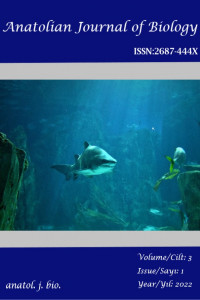Diversity and Status of Butterflies (Lepidoptera: Rhopalocera) found in PC Hills, Leyte (Philippines)
Diversity and Status of Butterflies (Lepidoptera: Rhopalocera) found in PC Hills, Leyte (Philippines)
diversity, DNA barcoding, morphology, Rhopalocera,
___
- [1] S. Willis, J. Hill, C. Thomas, D. Roy, R. Fox, D. Blakeley and B. Huntley, "Assisted colonization in a changing climate: a test-study using two U.K. butterflies.," Conservation Letters, no. 2, pp. 46-52, 2009.
- [2] K. Nuneza, O. Nuneza and A. Barrion-Dupo, "Species richness of Lepidoptera in bega watershed, Prosperidad, Agusan del Sura, Philippines.," Bulletin of Enironment, Pharmacology, and Life Sciences, vol. 5, pp. 83-90, 2016.
- [3] P. Nowicki, J. Settele and P. W. M. Henry, "Butterfly monitoring methods: the ideal and the real world.," Israel Journal of Ecology and Evolution, vol. 54, pp. 69-88, 2008.
- [4] D. Roy, P. Rothery, D. Moss, E. Pollard and J. Thomas, "Butterfly numbers and weather: Predicting historical trends in abundance and the future effects of climate change.," Journal of Animal Ecology, vol. 70, p. 201 – 217, 2008.
- [5] J. Thomas, "Monitoring change in the abundance and distribution of insects using butterflies and other indicator groups. Philosophical transactions of the Royal Society of London.," Series B, Biological sciences, vol. 360, p. 339–357., 2005.
- [6] A. Caldas and R. Robbins, "Modified Pollard transects for assessing tropical butterfly abundance and diversity.," Biological Conservation,, vol. 110, p. 211 – 219., 2003..
- [7] A. Mohagan and C. Treadaway, "Diversity and status of butterflies across vegetation types of Mt. Hamiguitan, Davao Oriental, Philippines.," Asian Journal of Biodiversity, 2010.
- [8] A. Mohagan, D. Mohagan and A. Tambuli, "Diversity of butterflies in the selected key biodiversity areas of Mindanao, Philippines.," Asian Journal of Biodiversity, 2011.
- [9] J. Toledo and A. Mohagan, "Diversity and status of butterflies in Mt. Timpoong and Mt. Hibok-hibok, Camiguin Island, Philippines.," JPAIR Multidisciplinary Research, 2011.
- [10] P. M. Staff, "Republic Act No. 9147.," 2001. [Online]. Available: https://www.pms.gov.ph/. [Accessed May 2020].
- [11] R. Ramirez and A. Mohagan, "Diversity and status of butterflies in Maitum Village, Tandag, Surigao del Sur, Philippines.," Asian Journal of Biodiversity, 2012.
- [12] O. H. D. Zoo, "Butterfly: taking science to the backyard.," 2011.
- [13] J. Badon, L. Lahom-Cristobal and A. Talavera, "Illustrated Lists of Philippine Butterflies.," 2013. [Online].
- [14] D. Micklos, G. Freyer and D. Crotty, in DNA Science, New York, Cold Spring Harbor Laboratory Press, 2003, p. 575 pp..
- [15] R. Colwell and J. Elsensohn, "EstimateS turns 20: statistical estimation of species richness and shared species from samples, with non-parametric extrapolation.," Ecography, vol. 37, p. 609–613., 2014.
- [16] J. R. Sovell, "Butterfly Community Monitoring on City Of Boulder Open Space and Mountain Parks Property: Analysis of the Changes in Species Richness and Diversity from 2002 to 2016.," Colorado Natural Heritage Program, Colorado State University, Fort Collins, Colorado, 2017.
- [17] C. &. S. H. Treadaway, "Revised checklist of the butterflies of the Philippine Islands (Lepidoptera: Rhopalocera).," Frankfurt am Main: Entomologischer Verein Apollo, 2012.
- [18] L. Vu and C. Vu, "Diversity Pattern of Butterfly Communities (Lepidoptera, Papilionoidae) in Different Habitat Types in a Tropical Rain Forest of Southern Vietnam," nternational Scholarly Research Notices, 2011.
- [19] F. Danielsen and C. Treadaway, "Priority conservation areas for butterflies (Lepidoptera: Rhopalocera) in the Philippine islands.," Animal Conservation, vol. 7, p. 79 – 92. , 2004.
- [20] IUCN, "The IUCN Red List of Threatened Species. Version 2020-1.," 2020. [Online]. Available: https://www.iucnredlist.org.. [Accessed August 2020].
- [21] A. Rodrigues, J. Pilgrim, J. Lamoreux, M. Hoffmann and T. Brooks, "The value of the IUCN Red List for conservation.," Trends in Ecology & Evolution, vol. 21, pp. 71-76, 2006.
- [22] C. Goforth, "Collecting insects: making an insect kill jar.," 2010. [Online]. Available: https://thedragonflywoman.com/2010/10/05/killjars/ . [Accessed September 2018].
- ISSN: 2687-444X
- Yayın Aralığı: Yılda 2 Sayı
- Başlangıç: 2020
- Yayıncı: Mehmet KARADAYI
Sean Ed Gregory IGANO, Ranz Brendan GABOR, Baron Arthur CABALONA, Numerıano Amer GUTİERREZ
Evaluation of Glycyrrhiza Species as Medicinal Plant
Furkan ÇOLAK, Mucip GENİŞEL, İbrahim Seyda URAS
Conserved amino acids in HCoV-HKU1 and SARS-Cov2 at RNA-dependent RNA polymerase (RdRp) motifs
Belkis ATASEVER ARSLAN, Gamze GÜNAL SADIK, Ahmet Can TİMUÇİN, Seda KUŞOĞLU GÜLTEKİN, Ayşegül YANIK
Özlem GÜLMEZ, Nurcan ALBAYRAK İSKENDER, Halil ŞENOL, Ömer Faruk ALGUR
Vitamin D, Vitamin B12, Folate, Iron and Creatine Kinase in Multiple Sclerotic Patients Who Smoke
